|
Kerosene Mantle Lamps and burners sold in North America
Introduction
The histories of America's kerosene mantle lamp companies tend to be ephemeral in that a lot was never written down and no one saw the reason to keep what was written down beyond their immediate usefulness. Much of a company's history was tossed out when no longer needed in day to day commerce and never passed down from generation to generation. Much of the time we only have a burner or a lamp and an old magazine advertisement or if lucky an old company brochure or catalogue that someone never got around to throwing out. When a company has a name in common use today such as The Home Supply Company or Solar Lamp Company web searches produce thousands of results of modern companies that use those key words. Other companies did not have enough surviving information to make it onto the web. Surviving information on most of these companies is scant and often requires considerable sleuthing. to find anything that survives.
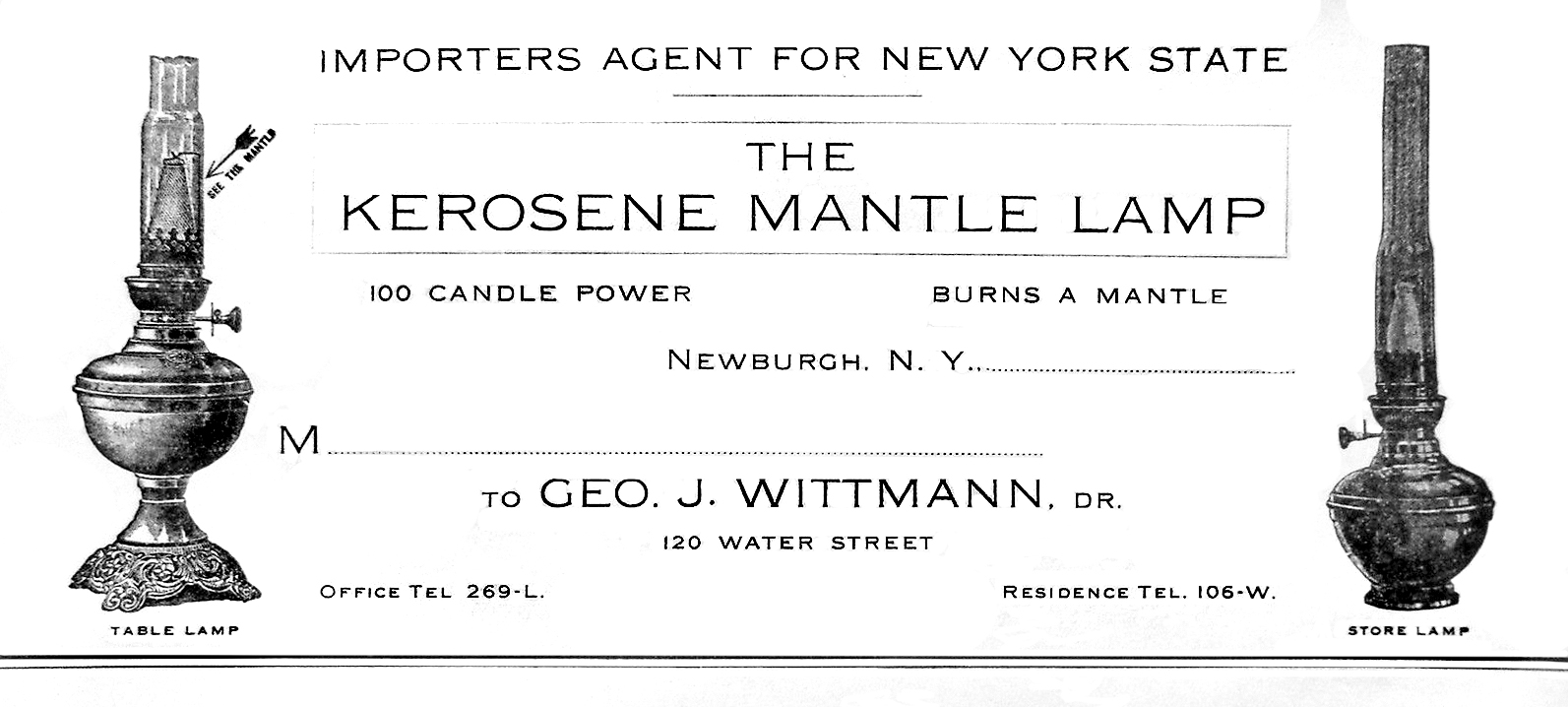
Many of these American companies were based upon importing German made burners, chimneys, wicks, and mantles then pairing them with American manufactured fonts or offering side draft burners alone as mantle burner upgrades to owners of flat wick lamps. These companies only survived seven years or less before the beginning of World War I in Europe cut off imports from Germany in 1914.
Thankfully Anton Kaim has exhaustively researched the German burners that were imported into North America. He has published an excellent book called "The Evolution of the Kerosene Mantle Burner". This is a self published book sold directly by the author and does a very good job of covering the inception and comparative evolution of the mantle burner. This book is an excellent reference for burner and parts identification. The book covers the Burners developed in Europe, German burners imported to North America and Aladdin brand burners. Anton's book used in conjunction the few surviving documents from early American mantle lamp companies provides a more complete view of the early companies founded on importing German manufactured burners. I consider Anton's book to be a must for the book shelf of anyone interested in the early history of mantle lamps in North America. It is an excellent resource for mantle burner design, evolution and history.
The companies that survived World War I were able to do so by having a source of American made burners or other product lines to rely upon. There were some companies that just could not gain marketing traction and ceased operations when the money ran out. The San Diego lamp is an excellent example. Like most other mantle lamp companies their business model depended upon having independent sales agents selling in their regions. They evidently could not attract enough sales agents to be profitable. Today almost all of the surviving San Diego lamps can be traced back to California. Other companies that survived World War I went out of business during the great depression when sales were not high enough to keep the company running.
With the exception Aladdin the last American manufacturers of non-pressurized kerosene mantle lamps fell away or dropped their lamps from production soon after World War II when rural America became electrified and the market for kerosene lamps shrunk dramatically. Some of these companies still exist but with completely different product lines and often different names. A prime example is the Farmor manufacturing company which stopped manufacturing kerosene mantle lamps in the late 1940s and exists today as the Keller Mfg./Gardex Company, www.gardexusa.com , specializing in garden tools ( A product line they introduced during WWII for Victory gardens).
An example of just some of the non-Aladdin kerosene mantle lamps that were sold in North America.:
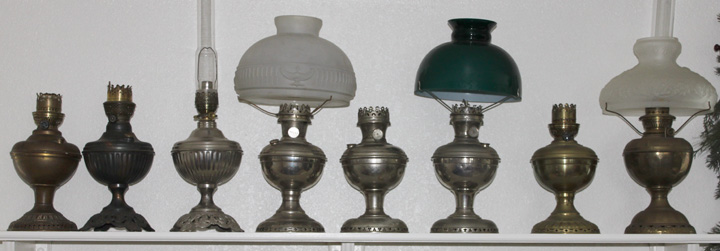
United Factories Wonder lamp, Kronos, Canchester, Solar, Daylite, Bright as Day, Felbollin, San Diego
Flame Spreaders used on different brands of mantle lamps
American Mantle Lamp Manufacturers (made mantle
lamps for other companies):
Early mantle lamp offerings were driven by economics. Germany, where the mantle lamp was invented, was the early source for mantle lamps. Complete mantle lamps were relatively bulky. It was a lot cheaper just to ship burners, chimneys, and mantles. Which meant that American entrepreneurs needed to source lamp founts locally or just offer side draft burners as upgrades to existing flat wick lamps. These American entrepreneurs went to American companies producing brass lamps asking for lamp fonts that they could use with the burners they wanted to import. Several companies, including Plume and Atwood, Edward Miller and Co., Manhattan brass, and Scovill Manufacturing Co. responded with fonts, allowing American entrepreneurs to offer complete mantle lamps, giving birth to the American mantle lamp industry. Early on these new lamp fonts were made from existing round wick lamp tooling that was modified to take the various German made burners. They chose to rework existing tooling because of economics. It being cheaper and faster to rework existing font tooling than to create new designs from scratch. You can trace the roots of early mantle lamp fonts by using the book"center-draft Kerosene Lamps 1884-1940 identification and value guide" by J. W. Courter, ISBN: 978-1-57432-566-9, profusely illustrated, 448 pages. Copies can be purchased from the author. Plume and Atwood went a step further and developed their own burner to compete with imported German burners. Some entrepreneurs designed their own burner and had them manufactured in America. Bradly and Hubbard briefly manufactured a mantle lamp for the San Diego mantle Lamp Company using their radiant 4 tooling. The San Diego company could not gain marketing traction and soon failed. After that Bradly and Hubbard stayed out of the mantle lamp manufacturing business except briefly just prior to WWII when they modified their RAYO burner tooling to create a mantle lamp for Montgomery Wards. America entering WWII and the restriction on brass soon ended production of RAYOs and the Wards mantle lamp. The Sea blockade of WWI starting in 1914 ended the importation of German made burners, chimneys and mantles, putting American companies that relied upon burners, chimneys and mantles out of business.
There were only a few American lamp companies that had the interest and facilities to tool up for and manufacture brass lamps for small lamp marketing companies. These companies manufactured their own lamps as well as mantle lamps for mantle lamp marketing companies.
Bradly & Hubbard manufacturing Co. manufactured a mantle lamp for the
San Diego Kerosene mantle lamp Company using their Radiant 4
model tooling for the fonts. Then in 1941 they manufactured a
mantle lamp exclusively for Montgomery Wards based upon Rayo
tooling so it looked like a Rayo mantle lamp. There were two German companies that offered incandescent mantle burners for use on Rayo Lamps. Learn more about Bradly & Hubbard
Edward Miller & Co. Was a major American manufacturer of brass kerosene lamps both under their own brand names and for other companies. They began by modifying existing round wick lamp tooling to fit German made burners and selling them to American entrepreneurs. In 1909 The Miller Mantle Lamp Department was formed to manufacture mantle lamps. Their first products were the Sundart lamp sold under the Edward Miller name, the 1909 CONTRACO lamp and the Lumo lamp. These were followed by several other mantle lamps similar to the Lumo lamp. I am aware of at least 8 different versions in this family of lamps. These lamps shared the same basic burner basket and wick riser design. All of which presented a relatively inexpensive way to enter into the mantle lamp business. Miller manufactured Bright-As-Day (Sears), DayLite, The Thomas Mfg.
Co, Lumo, Sunlight (Montgomery Wards), Rider , CONTRACO (1909 ) and probably more lamp brands. Miller also produced and sold the Sundart mantle lamp under the Edward Miller and Co. name.
Prior to WWI Edward Miller & Co. modified their smooth bowl Juno center draft lamp tooling to create side draft founts with standard number 3 threads and sold the founts to other companies who paired the founts with incandescent mantle burners imported from Germany. The most recognized of these companies was United Factories who sold lamps under the brand name "Wonder Lamp". Later, they also modified their embossed bowl Juno lamp tooling to create an embossed side draft table font. Both this font and the smooth bowl side draft font were used in limited numbers with Beacon burners. Learn more about Edward Miller & company
Some mantle lamps manufactured by Edward Miller & Co.
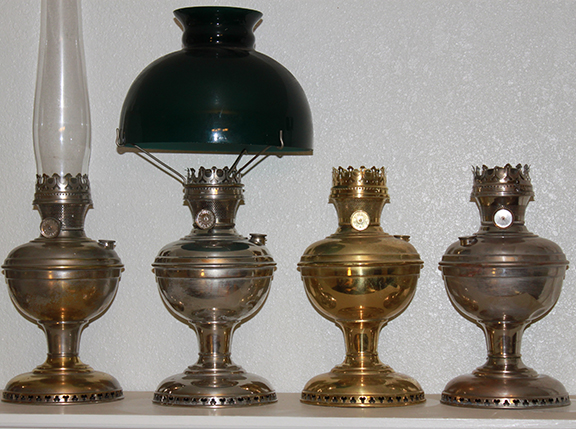
Daylite - Bright as Day - Lumo - Sunlight
Manhattan Brass Company (1865-1926) is primarily known as a manufacturer of center draft kerosene lamps but also manufactured side draft table founts that used different burners, Beacon, Canchester, Fellboelin, and Kronos. These burners were all used on table founts that used their Yale No. 2 tooling modified for side draft burners. According to J. W. Courter's book "center-draft Kerosene Lamps 1884-1940" The company " made lamps on custom order for other companies and retail stores". Judging by the the different burners used this series of lamps were probably marketed between 1907 and 1925 or 1926. In May, 1926, the Manhattan Brass Company sold its plant and went into voluntary liquidation.
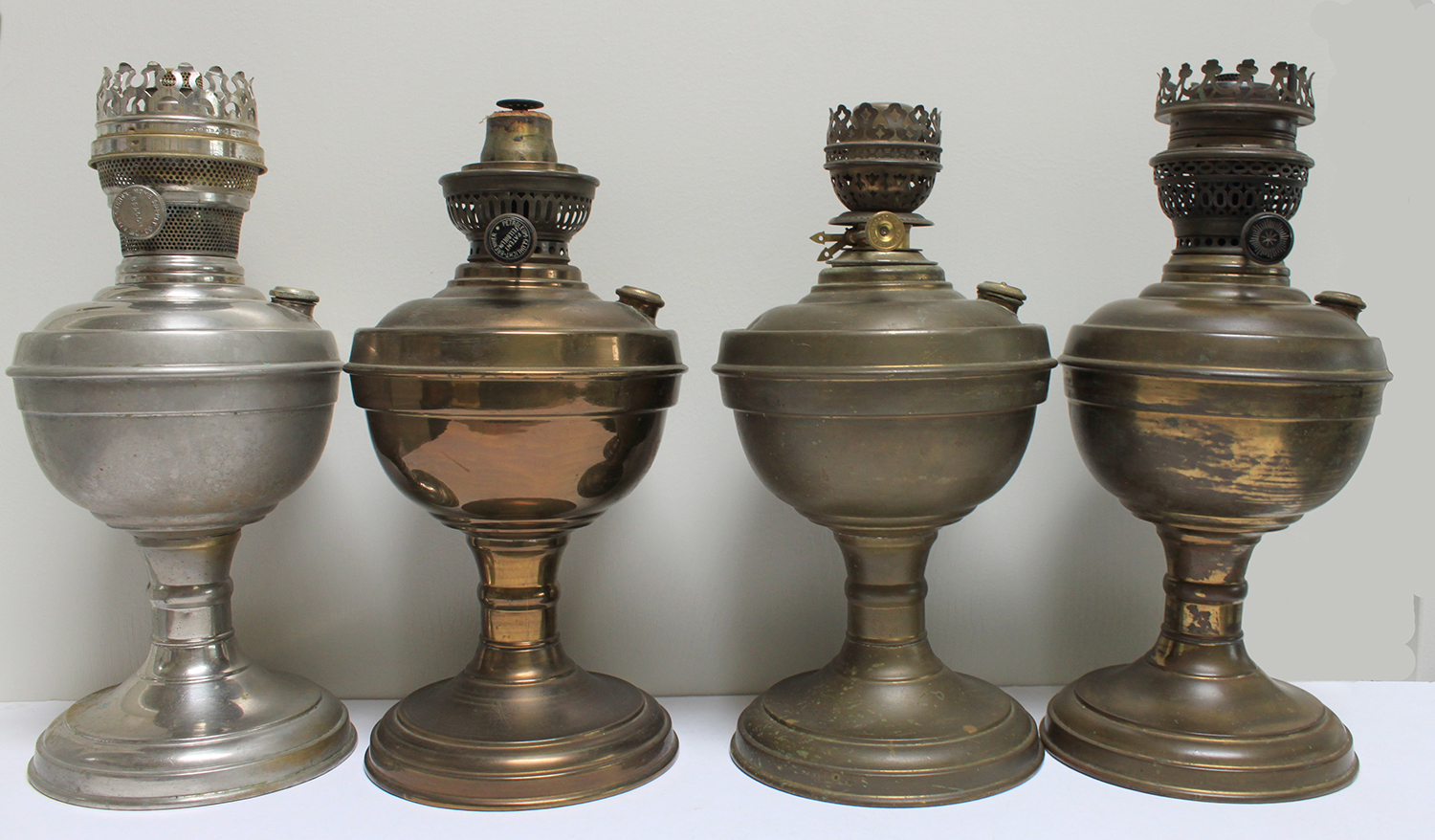
Lamps with table founts all made from modified Yale No. 2 tooling by the Manhattan Brass company.
Beacon, Fellboelin, Canchester, and Kronos.
Plume & Atwood Was a major American manufacturer of brass kerosene lamps both under their own brand names and others. They manufactured mantle lamps
for Aladdin (model 1 through Nashville model C) CONTRACO, Beacon,
Solar, Kim, Lumineer, Sunbeam, Universal and possibly others. They also
manufactured and sold fonts to companies that paired them with German burners. These became known by the label on the burner such as Practicus and Fellboelin. Learn more about Plume and Atwood
Scovill Manufacturing Co. manufactured brass products from 1802 through 1956 in Waterbury Connecticut. In 1957 they changed their name to Scovill Fastener and moved their operations to Clarksville Georgia where they are in business today. During the late 1800's and early 1900's they manufactured brass burners for other companies. Early on they manufactured a couple lines of flat wick burners. They manufactured the burners and mantle frames for lamps Welsbach. In the 1906 to 1912 time frame they manufactured burners for the Canchester lighting company. It was Canchester's non payment to Scovill manufacturing that brought about the lawsuit that caused Canchester to go into bankruptcy. In 1904 Scovill manufacturing company purchased The Matthews and Willard Manufacturing company which manufactured a range of brass products, including a wide range of center draft kerosene brass lamps and bicycle lamps. The flame spreaders on their center draft lamps were marked "M&W". Note that I have found inconclusive evidence on a web site that M&W may have manufactured some burners for Aladdin. I will be looking for conformation and which burners this may be. Scovill Manufacturing, M&W manufacturing and Plume & Atwood were all located in the same town, Waterbury, CT, as was another company reported to make brass lamps, the American Brass Company.
An interesting side note for Scovill Manufacturing company comes from their payroll records between 1862 through 1916. During those years about half their employees were women and the company paid equal wages for equal work. Learn more about the Scovill Manufacturing Company
Mantle Lamp Brands:
Beacon Brand name owned by the Home Supply
company. The company was founded in 1910 by J. E. Baldrey. They
merged with the Solar lamp Company in 1924. Side draft mantle
lamps manufactured by Plume & Atwood
Bright-As-Day A
Sears brand introduced in 1912, manufactured by Edward Miller & Co. Mantle Lamp Department
Canchester A short lived American mantle lamp
company that sold lamps with a unique incandescent mantle burner design. Approximately 1906 through 1912.
Capitol Mantle lamp from the Capitol Gas Mantle
Company of Des Moines Iowa.
CONIA - H. Schneider brand name around 1909. Manufacturer claimed
228 cp. The burner was sold as a mantle lamp and the burner was offered alone as a conversion for Rayo lamps.
CONTRACO (Connecticut Trading Company)
was formed in 1907 to import a line of alcohol lamps, stoves, irons and Practicus incandescent mantle burners from Germany to sell to regional sales agents. They were soon offering complete Practicus lamps with the Practicus burner mounted on lamp bases made by Plume and Atwood. By 1908 they were offering CONTRACO center draft mantle lamps manufactured by Plume & Atwood. Starting in 1909 they were selling CONTRACO lamps manufactured by the new Edward Miller & Co. mantle lamp department. These lamps appear to be identical to the Sundart lamp except for the labeling.
Daylite Brand of the Daylight company which
was formed by a small group of four former Aladdin employees.
The lamps were manufactured by Edward Miller & Co Mantle Lamp Department.
Esso 125cp burner manufactured by Ehrich & Graetz
of Germany. This burner was offered
by Montgomery Ward on lamps in from at least 1936 though 1939
when lamp shipments were halted by the battle for the Atlantic. A
version of this burner was also sold into the UK on the Famos
120 lamps. It his a very high quality burner that
adjusts very smoothly and produces more light than its competitors
(due mostly to the large mantle size).
Improved Eugeos centre draft lamp and burner manufactured by Ehrich & Graetz
of Germany. As near as I can determine this lamp and the centre draft version of the Eugeos burner were never sold in North America. It is included here because I found a burner in California. And where there is one there might be others.
Famos Series
of lamps manufactured in Germany (Ehrich & Graetz ) and England
(Veritas). The
burners are designed in Germany by Ehrich & Graetz.
There are several versions of this burner made over the years
in both centre and side draft versions. This
brand has a rich complicated history spanning multiple companies,
countries of manufacture, and over 3 decades of evolution. While these lamps were never sold into the United States they are too important to ignore. The Superspeed 120 burner, manufactured by E&G, was exported to the US and used on mantle lamps sold by Montgomery Ward in the 1930s just prior to the start of WWII. NOTE: This link goes to a web site dedicated to Famos lamps. The site is not an active forum, however it includes a wealth of information covering the various Famos lamps made both in the UK and Germany.
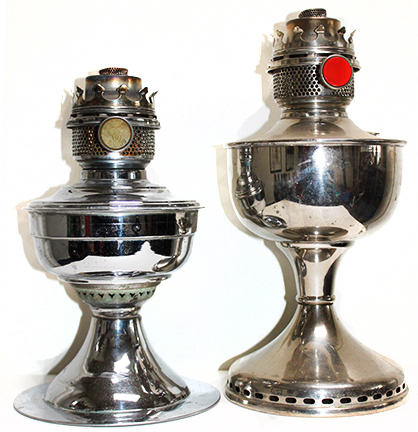
Veritas Superspeed and FAMOS 120CP table lamps
Farmor Manufacturing Co. of St. Louis Missouri. Manufactured
mantle lamps from 1935 into the 1940's. Many retailed by Sears under
the "Lightmaster" brand. Most
lamps were short deco glass table lamps. Some metal lamps with
wood stems, vase lamps and shelf lamps were also made. The Farmor lamp division ceased operations in the late 1940's and the company now makes garden tools. Page 1 covers the company history, the burner, chimney and mantles. Page 2 covers the different styles of lamps.
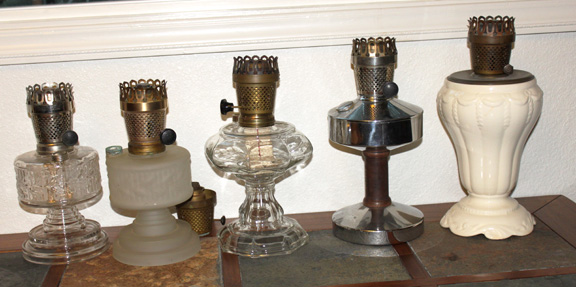
Some of the Farmor lamps
Felbollin German lamp brand. Side draft
burners sold in the US on Plume and Atwood 1-1/2 qt fancy foot
and hanging fonts. Black glass disc on wick adjuster
knob labeled in white lettering. Around edge labeled "PETROLI
UN-GLOHLIGHT-BRUNNER" In
the center of the knob on two lines is: "PATENT FELBOLLIN".
Ironclad Sold by Sherwood Ltd in the UK from 1925. Not imported to the United States, but some examples may be found in the US. Description for for the Ironclad model 2.
Ker-O-Lite (Kero-Lite) The
model 160 Kero-Lite was Coleman's late entry into the American
non pressurized kerosene mantle lamp market. It
was introduced in 1939 and remained in production through World
War II. It
is a side draft mantle burner on a glass lamp.
Kim lamp Manufactured by Plume & Atwood. It
appears to be a duplicate of the Aladdin model 1. Likely 1908 production only.
Kronos Side draft burner manufactured by Hugo Schneider in Germany. Burners were imported to the United States around 1908 both to be put on lamps and sold as complete lamps and as an Incandescent mantle burner upgrade to owners of flat wick lamps. When WWI started in Europe imports ceased.
Liberty Burner manufactured by Ehrich & Graetz
Lumo The Lumo brand was used on three different lamps so discussing them can get confusing unless you know which one you are referring to. The earliest is a brass round wick table lamp manufactured by Edward Miller & Co. Another is a German made side draft mantle burner manufactured by Hirschhorn, exported to the John S. Noel Company in the US. The third is a center draft mantle lamp manufactured by Edward Miller and Co Mantle Lamp Division, using a variation of Miller's standard mantle lamp design. This lamp was also sold by the John S. Noel Company.
Montgomery Ward commissioned their own non pressurized kerosene mantle
lamps and mostly sold them under their own house brands.
Montgomery Ward Radiant 1913 through 1916, manufactured by Plume & Atwood
Montgomery Ward Sunlight lamps 1920 through 1922 manufactured by E. Miller & Co. Mantle Lamp Department
Montgomery Ward 1936 through 1939
lamps, Burner manufactured by E&G in Germany. lamps sold by Wards until 1939 when the Battle for the
Atlantic started.
Montgomery Ward 1940 through early
1942 lamps manufactured by B&H. Montgomery Ward commissioned
B&H to manufacture non pressurized mantle lamps (based upon the
Rayo tooling) when WWII stopped imports of the E&G manufactured lamps. These lamps were discontinued early in 1942
when brass, chrome and nickel became restricted war materials.
Coleman Kero-Lite lamp Sold by Montgomery Ward during World War II Manufactured by Coleman
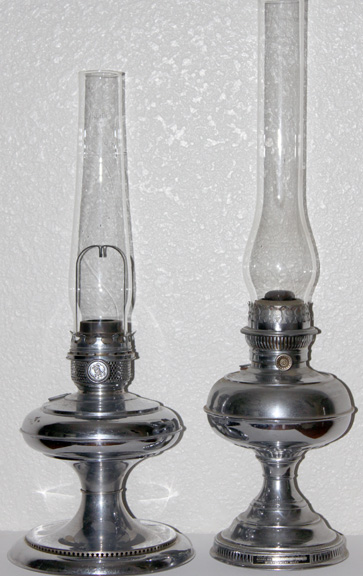
RIGHT: 1936 through 1939 E&G mantle lamp, LEFT: 1940 into 1942 B&H mantle lamp
NUSUN (UK) Trademark brand of J.W.&S. Ltd. They offered three mantle lamps around 1907, one side draft, the other two centre draft.
Practicus Name for first lamp sold by Aladdin in 1908. Practicus or Praktus is the name of the German manufactured burner made by E&G and imported to the United Sates. Aladdin sold these burners mounted to founts manufactured by Plume & Atwood.
Radiant (1913 -1916) Early Montgomery Wards brand manufactured by Plume & Atwood . This
should not be confused with the radiant line of round wick lamps
manufactured by B&H.
Rider Triple Air Mantle Lamp Manufactured by the Miller mantle Lamp Department for the A. G. Kaufman Mfg, CO.
San Diego Manufactured
in very small quantities by B&H for the San Diego Lamp and Manufacturing Company. Burner patented in 1909.
SAXONIA Brand sold by the U. S. Automatic Lighting Co. of Springfield, Mass. Sold as stand alone burners and as complete lamps using P&A and B&H lamp bodies. Burner manufactured in Germany.
Solar Mantle Lamp Company of Kansas City, Mo. sold duplicate to the Aladdin model
6, manufactured by Plume & Atwood after Aladdin had ceased offering the model 6.
Sun Mantle Lamp Company of Canton Ohio. The
burner is German made but I have yet to identify the fount manufacturer.
Sunbeam lamps and burners A brand owned by the Mantle Lamp Co. (Aladdin). Aladdin sold complete lamps and stand alone burners advertised as an upgrade for flat wick glass lamps. The early Sunbeam burner was Plume & Atwood's first side draft burner design. The second version was Plume & Atwood's second side draft burner design. Patented
in 1912.
SUNDART E.M. & Co. Manufactured and marketed by the Edward
Miller & Co. Mantle Lamp Department.
Sun Flame S.F. Appliances Limited, Rigefield N.J. , a division of Secony Mobil Oil Corp. These lamps were manufactured by Farmor Manufacturing Corp using the Farmor burner and glass lamp molds. Late 1930's into 1940's. Exported lamps into several countries. This page includes the Sunny model 505 sold in Australia using a Farmor burner modified in Australia to have a gallery riser.
Sunlight Montgomery Wards brand manufactured by the Edward Miller & Co. Mantle Lamp Department.
The Thomas manufacturing Company sold lamps manufactured by the Edward Miller & Co. Mantle Lamp Department.
United Factories of Kansas City Missouri. Formed
in 1907 by William H. Hoffstat. In 1913 United Factories
merged with the Sunshine Safety Lamp Company. United factories
used side draft German burners mounted on 1-1/2 qt fancy foot
lamp fonts manufactured by Plume
& Atwood. They used a filler cap with the company name
stamped into the top.
Wonder Lamps A United Factories brand that used German made burners manufactured
by H. Schneider AG. and lamp bases manufactured by Plume & Atwood.
Some side draft incandescent mantle burners marketed as upgrades to flat wick lamps.
AIDA - Side draft burner manufactured by J. Hirshhorn in Germany. Burners were imported into North American around 1907 or 1908.
Candesco - Side draft burner manufactured by Hugo Schneider in Germany. Imported to the United States in the mid 1930's
Frederick C. Gottschalk Co. of New York Sold Index Burners
Horton - the burner has a 1909 patent date and was sold to upgrade flat wick lamps.
INDEX - Manufactured by Hermann Hurwitz In Germany. Offered in America starting in 1907.
Lumineer - A brand owned by Aladdin. Plume & Atwood manufactured
side draft burners that were sold by Aladdin under the Lumineer name
as an upgrade for flat wick glass lamps.
Radia - Circa 1915 burner sold as an upgrade for flat wick lamps
Stirling - Sold unknown German manufactured side draft burner prior to World War I as an upgrade for flat wick lamps
Universal - About 1909 or 1910 side draft burner manufactured by Plume and Atwood as an upgrade for flat wick lamps. This burner is identical to the Sunbeam model 1 and Beacon model 1 burners.
Why are the early German burners imported into North America look so much alike and have the same general construction?
Answer by Anton Kaim (edited):
Many of the early German incandescent mantle burner designs are basically an Argand type of burner. The Argand patent was expired long before the incandescent mantle burners came along.. The long expired patent for the 1856 King design of the modern type of kerosene burner covered the air chamber (burner basket), the gallery and chimney clips used on the mantle burners. German incandescent mantle burner companies used the proven features of these patents as the basis for their own burner designs. This saved them both design time and money. Since the patents they were designed upon were expired they did not have to worry about copying a proven design or pay a royalty.
Only new ideas, like for example the Belgium L&B burner, could be successfully be patented. The problem with patenting a design such as the shape of the slotted openings of the air chamber, is that another manufacturer could put one hole extra in it, and by doing so, would be free to produce it without paying royalties. Patent protection for these kinds of design features often cost more money then they brought in.
Sometimes inventors just had bad luck, like the Wild & Wessel company. Their Cosmos burner idea was very clever and protect-able by patent, but they were never able to get it patented in Germany. Many other German burner makers took advantage of this opportunity and the Cosmos burner became one of the cheapest of all.
And why did the early German burners make use of similar tubular shaped chimneys?
" An interesting change in the gas lamp industry led to a class of mantle lamp burners. Around the turn of the century the common design of gas burners changed from an upright burner to in inverted gas burner. Suddenly there were hundreds of thousands of cylindrical gas light chimneys that no one would buy. In the early 1900's burners were designed to make use of this cylindrical style of gas light chimney. These burners had flame spreaders that did not noticeably spread the flame into the glass surface. This style of burner was seen on most of the German manufactured mantle lamp burners sold in the US. All of which disappeared at the beginning of WWI.* "
*Dr Herman Lahde
Mantles used on Mantle Lamps used in North America during the first half of the 1900s
There are basically three types of mantles that were used on Mantle lamps. The early mantles were narrow unmounted mantles mostly adapted from the upright gas mantle industry. With very rare exception supplies of all of these mantles were used up during or shortly after WWI.
Next is a class of mounted mantles that are permanently mounted to their frame and not replaceable without a new frame. The Aladdin mantles are an excellent example of this class. The frames are useless throwaways once the mantle breaks.
The third group are mantles that can be removed from their frames and replaced. The frames for these mantles have a hook at the center top of the frame wire where the top loop of an unmounted replacement mantle can be fitted. When a mantle breaks you keep the frame and replace the mantle. The Coleman Ker-O-Lite 160 mantle is an excellent example of this type. Since the frames are becoming somewhat rare you do not want to throw these frames away.
Mantle frames for mounting unmounted mantles
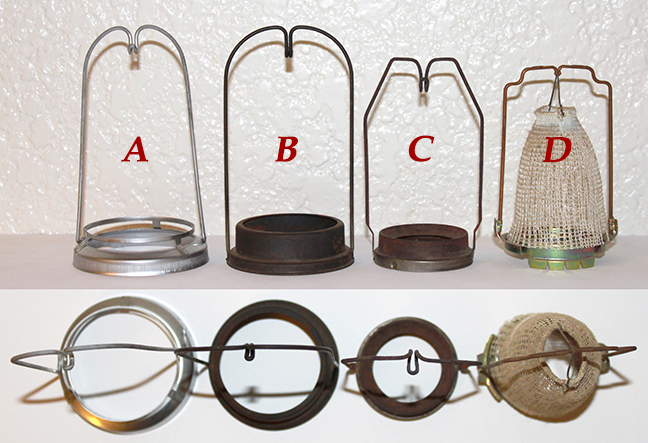
A. Mantle frame for Montgomery Ward Mantle Lamp manufactured by Bradly and Hubbard 1940 - 1941 only. Advertised at 100 CP
B Mantle frame used on Montgomery Ward lamps 1935 - 1939 manufactured by E&G. Advertised at 90 CP. This frame also fits the Famos 120 and Wonderlamps.
C. Mantle frame used on the Coleman Ker-O-lite 160. Introduced in 1939 and stayed in production at least through WWII. Montgomery Wards sold this lamp during the war years. Advertised at 45 CP
D. Aladdin Lox-on mantle provided as a size reference. Advertised at 60 CP.
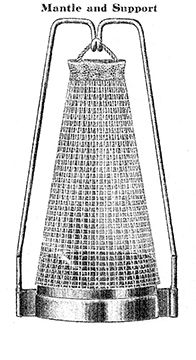 |
The earliest mantle lamps manufactured by Edward Miller & CO. used a mounted mantle that consisted of a cap mantle frame that could hang their unmounted mantles. These mantles and cap mantle frames were manufactured in Germany and imported to the US for use in the Miller family of mantle lamps from 1909 until 1914 when WWI began.
The frame consisted of a brass cone with a nickel steel or porcelain coated wire. They claimed that their cap mantle would fit any lamp that used cap mantles. |
Burner base sizes
During the 1800's the American kerosene lamp industry settled upon industry standard lamp collar and thread sizes. These were 00 and 0 for the miniature lamps commonly used for night lights and number 1, 2 and 3 for the larger flat wick lamps. In the later 1800's when the brighter round wick lamps were developed the large centre draft tube required a larger lamp collar opening. The early German side draft burners sold into North America had standard number 3 threads and often either a second set of number 2 threads or a reducing adapter to convert the burner for lamps that took number 2 threads. These side draft burners could be either mated with a font and sold as a complete lamp or sold alone as an incandescent mantle upgrade to owners of flat wick lamps. Early American manufactured side draft incandescent mantle burners were manufactured with standard number 3 threads so they could also be sold as burner upgrades for owners of flat wick lamps. European manufactured lamps not intended for North American export as stand alone burner upgrades usually had metric base threads.
NOTE: This chart is a draft and has not yet been finalized
Collar designation |
Diameter |
Number 1
No 2
No 3
Aladdin side draft,
Rayo *
most round wick lamps |
7/8th inch
1-3/16 in
1-3/4 in
2-1/8 in
2-1/4 in
2-3/8 in |
* At least 2 German manufactures manufactured incandescent mantle lamps specifically as upgrades to Rayo lamps |
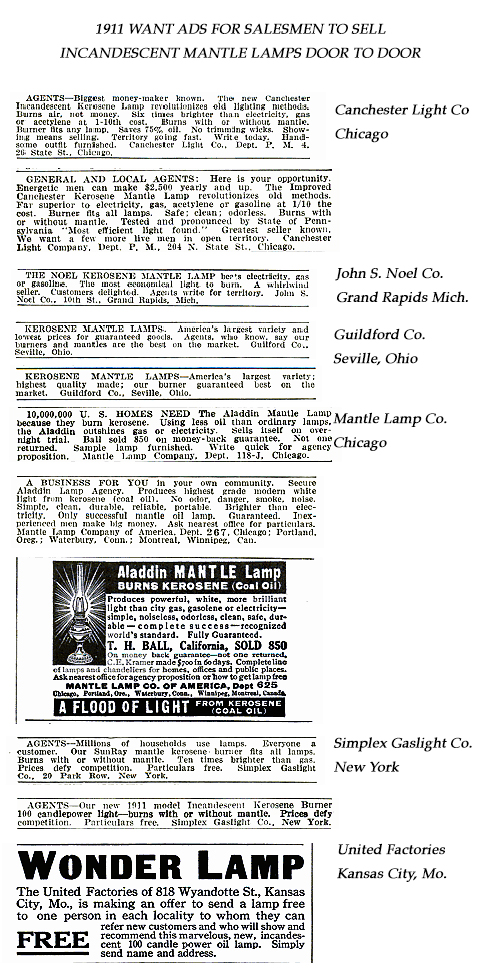
|
![]()
![]() Contents > Other
brands of mantle lamps sold in the U.S.
Contents > Other
brands of mantle lamps sold in the U.S. 








